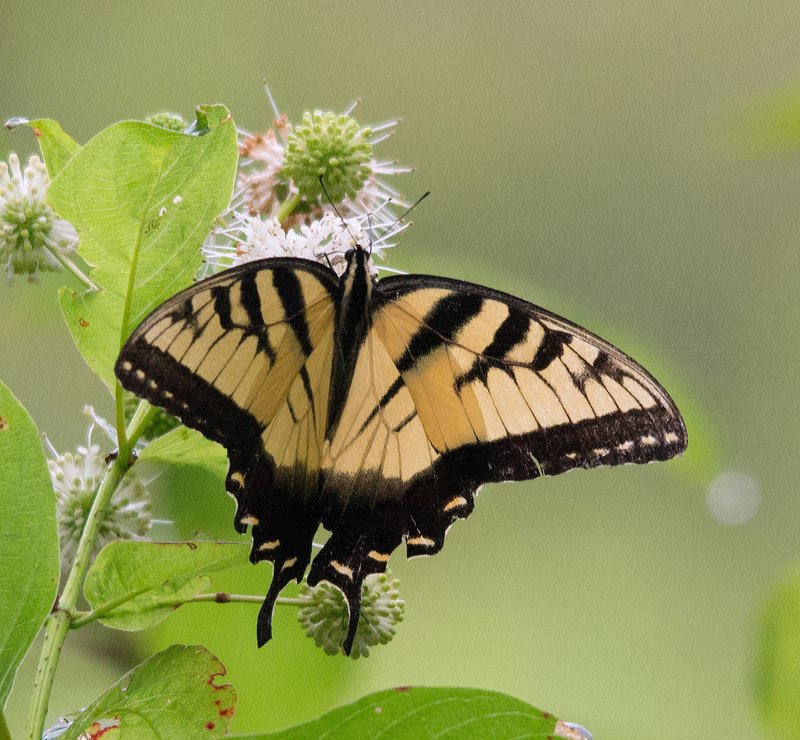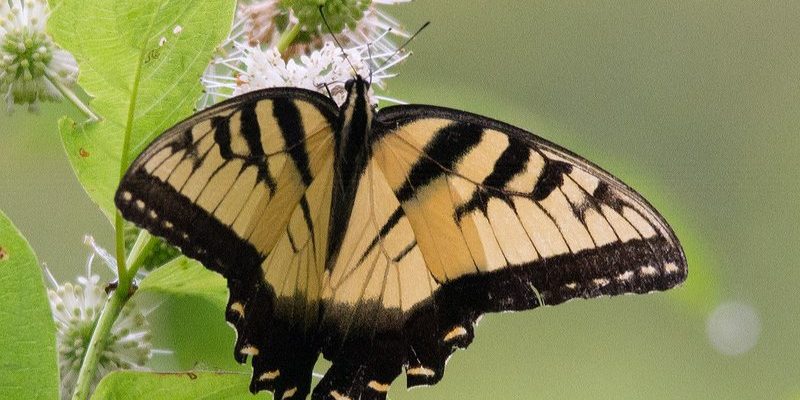
Imagine you’re walking through a garden filled with fragrant flowers, and suddenly, a stunning butterfly flits by. Its wings are a brilliant mix of yellow and black, almost like a living piece of art. That’s the Eastern Tiger Swallowtail, one of North America’s most beautiful butterflies. With its intricate patterns and graceful flight, it captures the hearts of nature lovers everywhere.
The Eastern Tiger Swallowtail (Papilio machaon) is not just a pretty face; it’s a fascinating creature with a unique life cycle and ecological importance. From its caterpillar stage, where it disguises itself as bird droppings, to the breathtaking transformation into a butterfly, every phase of its life is full of wonder. Let’s dive into what makes this butterfly so special!
Physical Characteristics
The Eastern Tiger Swallowtail is easily recognized for its striking appearance. Adults typically have a wingspan of about 3 to 5 inches. Their upper wings feature bold black tiger stripes against a golden yellow background. This striking coloration serves a purpose: it helps to ward off predators by mimicking more toxic species. Interestingly, females can also have a bluish hue on their lower wings, which adds to their visual appeal.
In their caterpillar stage, these butterflies look quite different. Baby caterpillars are green and can blend in with leaves, while older caterpillars take on a more unusual coloring. As they mature, they can mimic the appearance of bird droppings to evade their predators. It’s a clever trick that helps them stay safe until they’re ready to transform into their adult form.
Overall, the physical traits of the Eastern Tiger Swallowtail make it one of the most recognizable butterflies in North America. Their beauty invites admiration, while their adaptations highlight the cleverness of nature.
Habitat and Range
The Eastern Tiger Swallowtail is quite adaptable, thriving in various habitats. You can find it in woodlands, meadows, gardens, and along rivers. This butterfly loves sunny spots where flowers bloom, as these areas provide both food and opportunities for basking in the sun. They are prevalent throughout the eastern United States and parts of Canada, making them a familiar sight in many backyards and parks.
During warm months, you might see these butterflies fluttering about from late spring to early autumn. Their preference for habitats with abundant nectar sources, like lilacs or milkweed, influences where they choose to establish themselves. If you’re looking to attract them to your garden, planting native flowers can significantly increase your chances of spotting one.
As the seasons change, the Eastern Tiger Swallowtail adapts its behavior, often migrating or finding new locations to breed. This ability to thrive in different environments is one reason why they remain a common and beloved butterfly across their range.
Life Cycle of the Eastern Tiger Swallowtail
The life cycle of the Eastern Tiger Swallowtail is a fascinating journey. It begins when the female lays her eggs on the leaves of host plants, such as tulip trees, cherry trees, or willows. After a few days, the eggs hatch into tiny caterpillars. At this point, they are about the size of a pencil eraser and extremely vulnerable. They tend to stay hidden, munching on leaves and growing quickly.
As the caterpillar feeds, it goes through several molts, shedding its skin to accommodate its growing body. During this phase, they develop protective mechanisms, such as their bird droppings mimicry, which helps deter predators. In about two to three weeks, they will be ready for the next stage: pupation.
Diet and Feeding Habits
The diet of the Eastern Tiger Swallowtail varies at different life stages. As caterpillars, they primarily feast on the leaves of specific host plants. Favorite choices include black cherry, sweet bay, and willow trees. This diet allows them to grow quickly and develop the energy needed for their transformation into butterflies.
Once they become adults, their diet shifts to nectar. They are particularly drawn to flowers that have a rich supply of nectar. Common favorites include milkweed, lilacs, and goldenrod. When they feed, they use their long proboscis, which acts like a straw, to sip nectar from the flowers. This feeding not only nourishes them but also plays a crucial role in pollination, helping flowers to reproduce.
Interestingly, the feeding habits of the Eastern Tiger Swallowtail reflect their adaptability. They are often seen flitting from flower to flower, a lively dance that contributes to the health of their ecosystem. So, when you see them sipping nectar, remember that they’re not just feeding themselves; they’re also helping the plants thrive!
Behavioral Traits
The Eastern Tiger Swallowtail exhibits some intriguing behaviors that make them fascinating to observe. For instance, these butterflies are known for their graceful, fluttery flight patterns. They can often be seen gliding effortlessly from one flower to the next, occasionally basking in the sun with their wings spread wide. This behavior not only conserves energy but also helps them regulate their body temperature.
Another interesting aspect of their behavior is their social interactions. While adults can be quite solitary, they are sometimes seen congregating around sources of moisture, like puddles. This seems to be a way of obtaining essential minerals and nutrients that are not available from nectar alone. So, if you spot a group of them together, they might be engaging in what’s called “puddling,” a rather charming sight!
Moreover, during the mating season, male Eastern Tiger Swallowtails can be quite territorial. They often patrol specific areas, chasing away other males to establish their dominance. This behavior ensures that they have access to females when the time is right for mating. It’s a complex social structure that highlights their adaptability and survival instincts.
Conservation Status
Fortunately, the Eastern Tiger Swallowtail is not currently considered threatened or endangered. However, like many butterflies, they face challenges from habitat loss, climate change, and pesticide use. These factors can impact their numbers and disrupt their life cycles. Maintaining healthy ecosystems is essential for their continued presence in our environment.
Fortunately, there are many ways you can help support the Eastern Tiger Swallowtail. Planting native flowers in your garden, reducing pesticide use, and creating a butterfly-friendly habitat can all contribute to their well-being. By fostering environments where these beautiful butterflies can thrive, you play a critical role in their conservation.
Awareness and education are vital too. Understanding the importance of preserving habitats and promoting biodiversity can help ensure that the Eastern Tiger Swallowtail remains a common sight for generations to come. You can make a difference, one garden at a time!
Interesting Facts
The world of the Eastern Tiger Swallowtail is full of surprises. For one, did you know that these butterflies can live up to 2 weeks in their adult form? While that may not seem long, it’s crucial for them to mate and lay their eggs within that timeframe. Their lifespan is just another part of the fascinating cycle of life.
Additionally, the males are known for their striking coloration, which can sometimes lead to confusion. Many people might mistake them for their look-alikes—the Spicebush Swallowtail. The key difference? The Spicebush Swallowtail has a more blue or greenish hue on its lower wings. It’s a natural mix-up that highlights the beauty and diversity of butterflies.
Another fun fact is that the Eastern Tiger Swallowtail has the ability to flutter and fly quickly, reaching up to 12 miles per hour. This speed helps them evade predators. It’s no surprise that they are often seen darting across open fields and gardens, making them a delightful addition to any landscape.
FAQ
What plants do Eastern Tiger Swallowtail caterpillars eat?
Eastern Tiger Swallowtail caterpillars primarily feed on the leaves of specific host plants, such as black cherry, willow, and tulip trees. These plants provide the essential nutrients needed for their growth and development.
How can I attract Eastern Tiger Swallowtails to my garden?
To attract Eastern Tiger Swallowtails, consider planting native flowers that provide nectar. Options like milkweed, asters, and lilacs are especially appealing. Offering a sunny spot and minimizing pesticide use can also increase your chances of spotting these beautiful butterflies.
Are Eastern Tiger Swallowtails migratory?
While Eastern Tiger Swallowtails do not migrate long distances like some species, they may move to find suitable habitats, especially as they seek out flowering plants for nectar. Their behavior changes with the seasons, often leading them to more favorable environments.
What role do Eastern Tiger Swallowtails play in the ecosystem?
Eastern Tiger Swallowtails are important pollinators. As they feed on nectar, they transfer pollen between flowers, aiding in plant reproduction. This pollination process is crucial for maintaining healthy ecosystems and biodiversity.
How long does the Eastern Tiger Swallowtail live?
The adult Eastern Tiger Swallowtail typically lives for about 1 to 2 weeks. This relatively short lifespan is spent mating and laying eggs, after which they complete their life cycle.
What are the natural predators of Eastern Tiger Swallowtails?
Natural predators of Eastern Tiger Swallowtails include birds, wasps, and other insects. Their ability to disguise themselves as bird droppings during their caterpillar stage helps protect them from potential threats.
What is the difference between male and female Eastern Tiger Swallowtails?
Males and females of the Eastern Tiger Swallowtail are visually distinct. Males typically have brighter yellow and black coloration, while females can present a bluish tint on their lower wings. This difference is an indicator of sexual dimorphism in the species.
Can Eastern Tiger Swallowtails be found in urban areas?
Yes, Eastern Tiger Swallowtails can thrive in urban areas, especially in parks and gardens where there are plenty of flowering plants. They adapt well to various environments, and urban gardens can provide essential resources for them.
How do Eastern Tiger Swallowtails prepare for winter?
Eastern Tiger Swallowtails enter a form of dormancy during winter. As caterpillars, they may survive cold months by hibernating in their chrysalis stage. The timing and methods can vary based on environmental conditions and geographic location.
Are Eastern Tiger Swallowtails harmful to gardens?
No, Eastern Tiger Swallowtails are not harmful to gardens. While caterpillars may feed on certain plants, they typically target specific host plants and do not usually damage garden crops. In fact, their presence promotes biodiversity and helps with pollination.
What can I do to help Eastern Tiger Swallowtails?
You can support Eastern Tiger Swallowtails by planting native species in your garden, reducing pesticide usage, and creating butterfly-friendly environments. Educating yourself and others about their importance can also foster greater support for conservation efforts.

